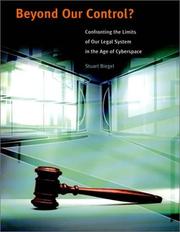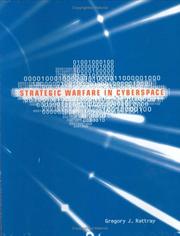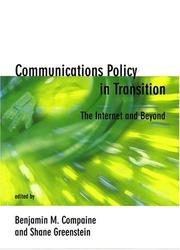| Listing 1 - 4 of 4 |
Sort by
|

ISBN: 9780262255738 0262255731 0585445990 9780585445991 9780262524162 1282096095 9786612096099 Year: 2001 Publisher: Cambridge, Mass. : MIT Press,
Abstract | Keywords | Export | Availability | Bookmark
 Loading...
Loading...Choose an application
- Reference Manager
- EndNote
- RefWorks (Direct export to RefWorks)
This book provides a framework for thinking about the law and cyberspace, examining the extent to which the Internet is currently under control and the extent to which it can or should be controlled. It focuses in part on the proliferation of MP3 file sharing, a practice made possible by the development of a file format that enables users to store large audio files with near-CD sound quality on a computer. By 1998, software available for free on the Web enabled users to copy existing digital files from CDs. Later technologies such as Napster and Gnutella allowed users to exchange MP3 files in cyberspace without having to post anything online. This ability of online users to download free music caused an uproar among music executives and many musicians, as well as a range of much-discussed legal action. Regulation strategies identified and discussed include legislation, policy changes, administrative agency activity, international cooperation, architectural changes, private ordering, and self-regulation. The book also applies major regulatory models to some of the most volatile Internet issues, including cyber-security, consumer fraud, free speech rights, intellectual property rights, and file-sharing programs.
Internet --- Computer networks --- Cyberspace --- Law and legislation --- INFORMATION SCIENCE/Technology & Policy --- INFORMATION SCIENCE/Internet Studies --- SCIENCE, TECHNOLOGY & SOCIETY/General --- Space and time --- Computers --- Telematics

ISBN: 0262282100 0585376751 9780585376752 9780262282109 9780262182096 0262182092 Year: 2001 Publisher: Cambridge, Mass. : MIT Press,
Abstract | Keywords | Export | Availability | Bookmark
 Loading...
Loading...Choose an application
- Reference Manager
- EndNote
- RefWorks (Direct export to RefWorks)
A comprehensive analysis of strategic information warfare waged via digital means as a distinct concern for the United States and its allies. In the "information age," information systems may serve as both weapons and targets. Although the media has paid a good deal of attention to information warfare, most treatments so far are overly broad and without analytical foundations. In this book Gregory Rattray offers a comprehensive analysis of strategic information warfare waged via digital means as a distinct concern for the United States and its allies. Rattray begins by analyzing salient features of information infrastructures and distinguishing strategic information warfare from other types of information-based competition, such as financial crime and economic espionage. He then establishes a conceptual framework for the successful conduct of strategic warfare in general, and of strategic information warfare in particular. Taking a historical perspective, he examines U.S. efforts to develop air bombardment capabilities in the period between World Wars I and II and compares them to U.S. efforts in the 1990s to develop the capability to conduct strategic information warfare. He concludes with recommendations for strengthening U.S. strategic information warfare defenses.
Information warfare. --- Strategy. --- Military & Naval Science --- Law, Politics & Government --- Military Science - General --- United States --- Military policy. --- Military strategy --- Military art and science --- Military doctrine --- INFORMATION SCIENCE/Technology & Policy --- Guerre de l'information --- Stratégie --- Etats-Unis --- Politique militaire

ISBN: 0262270714 0585446490 9780262270717 9780262032926 0262293390 9780585446493 0262032929 9780262293396 Year: 2001 Publisher: Cambridge, Mass. : MIT Press,
Abstract | Keywords | Export | Availability | Bookmark
 Loading...
Loading...Choose an application
- Reference Manager
- EndNote
- RefWorks (Direct export to RefWorks)
Until the 1980s, it was presumed that technical change in most communications services could easily be monitored from centralized state and federal agencies. This presumption was long outdated prior to the commercialization of the Internet. With the Internet, the long-forecast convergence of voice, video, and text bits became a reality. Legislation, capped by the Telecommunications Act of 1996, created new quasi-standards such as "fair" and "reasonable" for the FCC and courts to apply, leading to nonstop litigation and occasional gridlock. This book addresses some of the many telecommunications areas on which public policy makers, corporate strategists, and social activists must reach agreement. Topics include the regulation of access, Internet architecture in a commercial era, communications infrastructure development, the Digital Divide, and information policy issues such as intellectual property and the retransmission of TV programming via the Internet.
Communication policy --- Internet --- Telecommunication policy --- Journalism & Communications --- Communication & Mass Media --- Telecommunication --- Telecommunication and state --- DARPA Internet --- Internet (Computer network) --- Communication --- Communication and state --- State and communication --- Government policy --- Wide area networks (Computer networks) --- World Wide Web --- INFORMATION SCIENCE/Technology & Policy --- #SBIB:309H1012 --- Media: communicatiepolitieke aspecten / mediabeleid (nationaal en internationaal)

ISBN: 1282096575 0262256584 1423725417 9780262256582 9780262122382 0262122383 9780262621519 0262621517 Year: 2001 Publisher: Cambridge, Mass. : MIT Press,
Abstract | Keywords | Export | Availability | Bookmark
 Loading...
Loading...Choose an application
- Reference Manager
- EndNote
- RefWorks (Direct export to RefWorks)
In Crypto Anarchy, Cyberstates, and Pirate Utopias, Peter Ludlow extends the approach he used so successfully in High Noon on the Electronic Frontier, offering a collection of writings that reflects the eclectic nature of the online world, as well as its tremendous energy and creativity. This time the subject is the emergence of governance structures within online communities and the visions of political sovereignty shaping some of those communities. Ludlow views virtual communities as laboratories for conducting experiments in the construction of new societies and governance structures. While many online experiments will fail, Ludlow argues that given the synergy of the online world, new and superior governance structures may emerge. Indeed, utopian visions are not out of place, provided that we understand the new utopias to be fleeting localized "islands in the Net" and not permanent institutions. The book is organized in five sections. The first section considers the sovereignty of the Internet. The second section asks how widespread access to resources such as Pretty Good Privacy and anonymous remailers allows the possibility of "Crypto Anarchy"--Essentially carving out space for activities that lie outside the purview of nation states and other traditional powers. The third section shows how the growth of e-commerce is raising questions of legal jurisdiction and taxation for which the geographic boundaries of nation-states are obsolete. The fourth section looks at specific experimental governance structures evolved by online communities. The fifth section considers utopian and anti-utopian visions for cyberspace. Contributors Richard Barbrook, John Perry Barlow, William E. Baugh Jr., David S. Bennahum, Hakim Bey, David Brin, Andy Cameron, Dorothy E. Denning, Mark Dery, Kevin Doyle, Duncan Frissell, Eric Hughes, Karrie Jacobs, David Johnson, Peter Ludlow, Timothy C. May, Jennifer L. Mnookin, Nathan Newman, David G. Post, Jedediah S. Purdy, Charles J. Stivale.
Cyberspace --- Internet --- Anarchism --- State, The --- Sociology & Social History --- Social Sciences --- Social Change --- Social aspects --- Political aspects --- Administration --- Commonwealth, The --- Anarchism and anarchists --- Anarchy --- Sovereignty --- Political science --- Government, Resistance to --- Libertarianism --- Nihilism --- Socialism --- Space and time --- Computers --- Telematics --- Anarchism. --- State, The. --- Social aspects. --- Political aspects. --- INFORMATION SCIENCE/Technology & Policy --- edited by Peter Ludlow --- computer --- cybercultuur --- communicatie --- cyberspace --- technologie --- internet --- kunst en technologie --- 791.5 --- Cyberespace --- Anarchisme --- Etat --- Aspect social --- Aspect politique
| Listing 1 - 4 of 4 |
Sort by
|

 Search
Search Feedback
Feedback About UniCat
About UniCat  Help
Help News
News